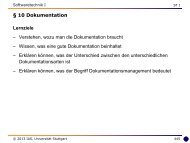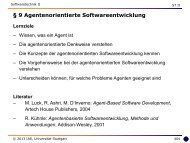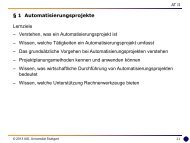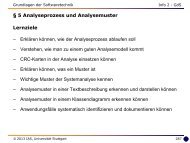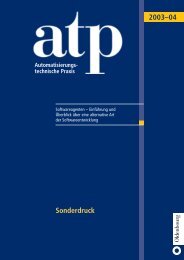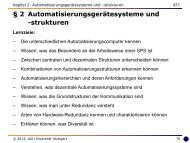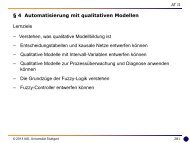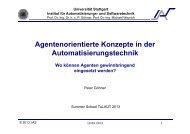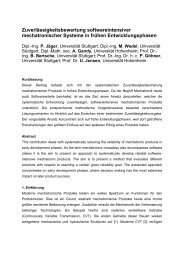Grundlagen FlexRay - Institut für Automatisierungs- und ...
Grundlagen FlexRay - Institut für Automatisierungs- und ...
Grundlagen FlexRay - Institut für Automatisierungs- und ...
You also want an ePaper? Increase the reach of your titles
YUMPU automatically turns print PDFs into web optimized ePapers that Google loves.
<strong>Gr<strong>und</strong>lagen</strong> <strong>FlexRay</strong> BasicsV 1.1 24<br />
2. Scenario – single Coldstart Node in the cluster<br />
After the Wakeup of a Coldstart node, it enters POC:startup state. As a next step, it<br />
checks weather there is already an active communication on the channels. In that case,<br />
it synchronizes itself to the cycle, and enters POC:normal active state.<br />
If there is no communication, the node starts the Startup procedure by sending a<br />
Collision Avoidance Symbol (CAS). This identifies the node als Leading Coldstart<br />
Node. After that, the node sends 4 Startup Sync Frames (SyF), see Figure 2.20 - (1). If<br />
no other node answers (like in this scenario), the Coldstart Node stops its activity after<br />
a defined number of retries, and waits for another node to take the role of Leading<br />
Coldstart Node.<br />
3. Scenario – two or more Coldstart Node in the cluster<br />
After “racing” for the role of Leading Startup Node, the winning node commences the<br />
Startup Procedure as described in scenario 2. All other Coldstart Nodes are called<br />
Following Coldstart Nodes. These commence scheduling after receiving the first two<br />
Sync Frames (SyF), and start synchronizing in the following cycle. In the fourth cycle,<br />
the Following Coldstart Node start sending Sync Frames on their own, the so called<br />
Coldstart Join (see Figure 2.19 and Figure 2.20 - (2)). All other nodes start scheduling<br />
at the 0 th cycle, followed by the synchronization. After the 7 th cycle, they start<br />
transmitting data (see Figure 2.20 - (3)). As with the 8th cycle, there is a normal<br />
communication on the bus, all nodes are in POC: normal active state.<br />
Figure 2.19 Startup sequence<br />
This behavior can be recorded and verified in CANoe, see Figure 2.20. In this case, two<br />
Coldstart Nodes have ben simulated by the software. The control unit <strong>und</strong>er test joins the<br />
communication as expected.<br />
Bäurle 12.10.2012




